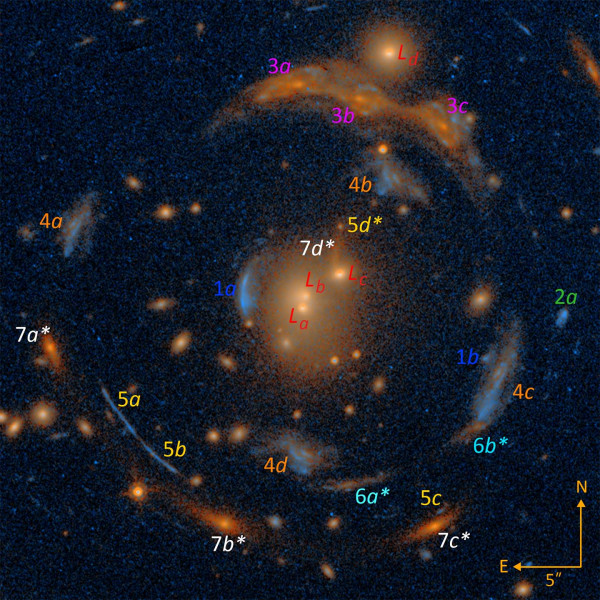Magnifying Deep Space Through the 'Carousel Lens'
September 18, 2024
By Marsha Fenner
In a rare and extraordinary discovery, researchers have identified a unique configuration of galaxies that form the most exquisitely aligned gravitational lens found to date. The Carousel Lens is a massive cluster-scale gravitational lens system that will enable researchers to delve deeper into the mysteries of the cosmos, including dark matter and dark energy.
“It’s an unprecedented discovery, and the computational model generated shows a highly promising prospect for measuring the properties of the cosmos, including those of dark matter and dark energy.” — Xiaosheng Huang, University of San Francisco
“This is an amazingly lucky ‘galactic line-up’ – a chance alignment of multiple galaxies across a line-of-sight spanning most of the observable universe,” said David Schlegel, a co-author of the study and a senior scientist in Berkeley Lab’s Physics Division. “Finding one such alignment is a needle in the haystack. Finding all of these is like eight needles precisely lined up inside that haystack.”
The Carousel Lens
The Carousel Lens is an alignment consisting of one foreground galaxy cluster (the ‘lens’) and seven background galaxies spanning immense cosmic distances and seen through the gravitationally distorted space-time around the lens. In the dramatic image below:

Hubble Space Telescope image of the Carousel Lens, taken in two 10-minute exposures, one using an optical filter and another using an infrared filter. The “L” indicators near the center (La, Lb, Lc, and Ld) show the most massive galaxies in the lensing cluster, located 5 billion light years away. Seven unique galaxies (numbered 1 through 7) – located an additional 2.6 to 7 billion light years beyond the lens – appear in multiple, distorted “fun-house mirror” iterations (indicated by each number’s letter index, e.g., a through d), as seen through the lens. (Credit: William Sheu/UCLA using Hubble Space Telescope data.)
The lensing cluster, located 5 billion light years away from Earth, is shown by its four brightest and most massive galaxies (indicated by La, Lb, Lc, and Ld), and these constitute the foreground of the image.
Seven unique galaxies (numbered 1 through 7), appear through the lens. These are located far beyond, at distances from 7.6 to 12 billion light years away from Earth, approaching the limit of the observable universe.
Each galaxy’s repeated appearances (indicated by each number’s letter index, e.g., a through d) show differences in shape that are curved and stretched into multiple “fun house mirror” iterations caused by the warped space-time around the lens.
Of particular interest is the discovery of an Einstein Cross – the largest known to date – shown in galaxy number 4’s multiple appearances (indicated by 4a, 4b, 4c, and 4d). This rare configuration of multiple images around the center of the lens is an indication of the symmetrical distribution of the lens’ mass (dominated by invisible dark matter) and plays a key role in the lens-modeling process.
Light traveling from far-distant space can be magnified and curved as it passes through the gravitationally distorted space-time of nearer galaxies or clusters of galaxies. In rare instances, a configuration of objects aligns nearly perfectly to form a strong gravitational lens. Using an abundance of new data from the Dark Energy Spectroscopic Instrument (DESI) Legacy Imaging Surveys, recent observations from NASA’s Hubble Space Telescope, and the Perlmutter supercomputer at the National Energy Research Scientific Computing Center (NERSC), the research team built on their earlier studies (in May 2020 and Feb 2021) to identify likely strong lens candidates, laying the groundwork for the current discovery.
“Our team has been searching for strong lenses and modeling the most valuable systems,” explains Xiaosheng Huang, a study co-author and member of Berkeley Lab’s Supernova Cosmology Project, and a professor of physics and astronomy at the University of San Francisco. “The Carousel Lens is an incredible alignment of seven galaxies in five groupings that line up nearly perfectly behind the foreground cluster lens. As they appear through the lens, the multiple images of each of the background galaxies form approximately concentric circular patterns around the foreground lens, as in a carousel. It’s an unprecedented discovery, and the computational model generated shows a highly promising prospect for measuring the properties of the cosmos, including those of dark matter and dark energy.”
The study also involved several Berkeley Lab student researchers, including the lead author, William Sheu, an undergraduate student intern with DESI at the beginning of this study, now a PhD student at UCLA and a DESI collaborator.
Closing in on Dark Matter, Dark Energy
The Carousel Lens will enable researchers to study dark energy and dark matter in entirely new ways based on the strength of the observational data and its computational model.
“This is an extremely unusual alignment, which by itself will provide a testbed for cosmological studies,” observes Nathalie Palanque-Delabrouille, director of Berkeley Lab’s Physics Division. “It also shows how the imaging done for DESI can be leveraged for other scientific applications,” such as investigating the mysteries of dark matter and the accelerating expansion of the universe, which is driven by dark energy.
About NERSC and Berkeley Lab
The National Energy Research Scientific Computing Center (NERSC) is a U.S. Department of Energy Office of Science User Facility that serves as the primary high performance computing center for scientific research sponsored by the Office of Science. Located at Lawrence Berkeley National Laboratory, NERSC serves almost 10,000 scientists at national laboratories and universities researching a wide range of problems in climate, fusion energy, materials science, physics, chemistry, computational biology, and other disciplines. Berkeley Lab is a DOE national laboratory located in Berkeley, California. It conducts unclassified scientific research and is managed by the University of California for the U.S. Department of Energy. »Learn more about computing sciences at Berkeley Lab.







